Foot and Ankle Medicine: Analysis of a Decade of Research in Renowned Brazilian Orthopedic Journals
Article Information
Thiago Batista Faleiro1 *, Jocelmo Brito de Souza2, Denisval Flores Cavalcanti1, Alexandre Vasconcelos de Meirelles1
1Santo Antônio Hospital / Irmã Dulce Social Works, Bonfim, Salvador, Bahia, Brazil
2Federal University of Bahia, Brazil
*Corresponding Author: Thiago Batista Faleiro, Santo Antônio Hospital, Irmã Dulce Social Works, road Dr. Augusto Viana, 40110-060, Bonfim, Salvador, Bahia, Brazil
Received: 22 March 2021; Accepted: 31 March 2021; Published: 06 April 2021
Citation: Thiago Batista Faleiro, Jocelmo Brito de Souza, Denisval Flores Cavalcanti, Alexandre Vasconcelos de Meirelles. Foot and Ankle Medicine: Analysis of a Decade of Research in Renowned Brazilian Orthopedic Journals. Journal of Orthopaedics and Sports Medicine 3 (2021): 030-038.
View / Download Pdf Share at FacebookAbstract
Evidence-based medicine is a new paradigm for medical practice in situations that generate uncertainties regarding disease diagnosis, prognosis, and therapeutic management, requiring professionals to develop expertise in the critical evaluation and validation of scientific publications. Thus, this study aimed to evaluate the articles published in Brazil between 2010 and 2019 on foot and ankle medicine. Three researchers independently searched for articles on foot and ankle medicine in three renowned Brazilian orthopedic journals, as follows: Revista Brasileira de Ortopedia, Acta Ortopédica Brasileira, and Revista Abtpé. In total, 296 articles were identified and complied with the inclusion criteria, being thus analyzed. Applying the Oxford hierarchy of evidence classification, we found that, across the three journals, most articles were at levels 4 and 5 of evidence and originated in the state of São Paulo. The most discussed topics were trauma, hallux valgus, pathologies of the calcaneus tendon, and ligament injuries. Given that the predominance of articles with a lower level of evidence has also been reported in the literature for international journals, initiatives that encourage an increase in the number, in the popularization, and the improvement of the level of evidence for foot and ankle medicine research in Brazil are warranted.
Keywords
Evidence based medicine; Foot and ankle; Orthopedic surgery
Foot and Ankle articles Foot and Ankle Research articles Foot and Ankle review articles Foot and Ankle PubMed articles Foot and Ankle PubMed Central articles Foot and Ankle 2023 articles Foot and Ankle 2024 articles Foot and Ankle Scopus articles Foot and Ankle impact factor journals Foot and Ankle Scopus journals Foot and Ankle PubMed journals Foot and Ankle medical journals Foot and Ankle free journals Foot and Ankle best journals Foot and Ankle top journals Foot and Ankle free medical journals Foot and Ankle famous journals Foot and Ankle Google Scholar indexed journals Medical practice articles Medical practice Research articles Medical practice review articles Medical practice PubMed articles Medical practice PubMed Central articles Medical practice 2023 articles Medical practice 2024 articles Medical practice Scopus articles Medical practice impact factor journals Medical practice Scopus journals Medical practice PubMed journals Medical practice medical journals Medical practice free journals Medical practice best journals Medical practice top journals Medical practice free medical journals Medical practice famous journals Medical practice Google Scholar indexed journals Therapeutic management articles Therapeutic management Research articles Therapeutic management review articles Therapeutic management PubMed articles Therapeutic management PubMed Central articles Therapeutic management 2023 articles Therapeutic management 2024 articles Therapeutic management Scopus articles Therapeutic management impact factor journals Therapeutic management Scopus journals Therapeutic management PubMed journals Therapeutic management medical journals Therapeutic management free journals Therapeutic management best journals Therapeutic management top journals Therapeutic management free medical journals Therapeutic management famous journals Therapeutic management Google Scholar indexed journals Decision-making articles Decision-making Research articles Decision-making review articles Decision-making PubMed articles Decision-making PubMed Central articles Decision-making 2023 articles Decision-making 2024 articles Decision-making Scopus articles Decision-making impact factor journals Decision-making Scopus journals Decision-making PubMed journals Decision-making medical journals Decision-making free journals Decision-making best journals Decision-making top journals Decision-making free medical journals Decision-making famous journals Decision-making Google Scholar indexed journals Diagnostic tests articles Diagnostic tests Research articles Diagnostic tests review articles Diagnostic tests PubMed articles Diagnostic tests PubMed Central articles Diagnostic tests 2023 articles Diagnostic tests 2024 articles Diagnostic tests Scopus articles Diagnostic tests impact factor journals Diagnostic tests Scopus journals Diagnostic tests PubMed journals Diagnostic tests medical journals Diagnostic tests free journals Diagnostic tests best journals Diagnostic tests top journals Diagnostic tests free medical journals Diagnostic tests famous journals Diagnostic tests Google Scholar indexed journals Traditional medicine articles Traditional medicine Research articles Traditional medicine review articles Traditional medicine PubMed articles Traditional medicine PubMed Central articles Traditional medicine 2023 articles Traditional medicine 2024 articles Traditional medicine Scopus articles Traditional medicine impact factor journals Traditional medicine Scopus journals Traditional medicine PubMed journals Traditional medicine medical journals Traditional medicine free journals Traditional medicine best journals Traditional medicine top journals Traditional medicine free medical journals Traditional medicine famous journals Traditional medicine Google Scholar indexed journals Prognosis, therapeutic effects articles Prognosis, therapeutic effects Research articles Prognosis, therapeutic effects review articles Prognosis, therapeutic effects PubMed articles Prognosis, therapeutic effects PubMed Central articles Prognosis, therapeutic effects 2023 articles Prognosis, therapeutic effects 2024 articles Prognosis, therapeutic effects Scopus articles Prognosis, therapeutic effects impact factor journals Prognosis, therapeutic effects Scopus journals Prognosis, therapeutic effects PubMed journals Prognosis, therapeutic effects medical journals Prognosis, therapeutic effects free journals Prognosis, therapeutic effects best journals Prognosis, therapeutic effects top journals Prognosis, therapeutic effects free medical journals Prognosis, therapeutic effects famous journals Prognosis, therapeutic effects Google Scholar indexed journals Rare damage articles Rare damage Research articles Rare damage review articles Rare damage PubMed articles Rare damage PubMed Central articles Rare damage 2023 articles Rare damage 2024 articles Rare damage Scopus articles Rare damage impact factor journals Rare damage Scopus journals Rare damage PubMed journals Rare damage medical journals Rare damage free journals Rare damage best journals Rare damage top journals Rare damage free medical journals Rare damage famous journals Rare damage Google Scholar indexed journals Common damage articles Common damage Research articles Common damage review articles Common damage PubMed articles Common damage PubMed Central articles Common damage 2023 articles Common damage 2024 articles Common damage Scopus articles Common damage impact factor journals Common damage Scopus journals Common damage PubMed journals Common damage medical journals Common damage free journals Common damage best journals Common damage top journals Common damage free medical journals Common damage famous journals Common damage Google Scholar indexed journals Screening utility articles Screening utility Research articles Screening utility review articles Screening utility PubMed articles Screening utility PubMed Central articles Screening utility 2023 articles Screening utility 2024 articles Screening utility Scopus articles Screening utility impact factor journals Screening utility Scopus journals Screening utility PubMed journals Screening utility medical journals Screening utility free journals Screening utility best journals Screening utility top journals Screening utility free medical journals Screening utility famous journals Screening utility Google Scholar indexed journals
Article Details
1. Introduction
Evidence-based medicine is a new paradigm for medical practice, especially in situations that generate uncertainties regarding disease diagnosis, prognosis, and therapeutic management; this approach requires professionals to develop expertise in the critical evaluation and validation of scientific publications [1]. Specifically, evidence-based medicine differs from traditional medicine in that it is not guided by intuition nor by pathophysiological reasoning, both of which relate to clinicians’ decision-making; instead, it is based on literature research and clinical evidence evaluations, thereby requiring the development of new skills for most doctors.
Moreover, owing to the large increase in the number of scientific publications and search tools and to help avoid methodological pitfalls-that can lead readers to misleading and dangerous decisions in clinical practice—evaluating these studies requires critical appraisal [2]. Although the practice of medicine has been based on empirical knowledge since at least the time of Galen of Pergamon, the term evidence-based medicine is more recent, appearing for the first time in a 1992 article [1]. The modern concept of evidence-based medicine is based on the notion that doctors’ decisions should be based not only on evidence in general, but also on evidence of the highest quality [3]. A cornerstone of evidence-based medicine is the hierarchical evidence classification system; this hierarchy is known as the levels of evidence. Doctors are encouraged to find the highest level of evidence to answer to clinical questions [4].
Several systems have been proposed for the classification of levels of evidence in evidence-based medicine. In the classification proposed by the “Oxford Center for Evidence-based Medicine” (OCEBM), there is a distinctive feature; the levels of evidence cover the entire range of clinical issues, in the order that the clinician requires. Namely, while most classification schemes consider the levels of evidence regarding therapeutic effects and damage, the OCEBM system allows for doctors and patients to assess evidence regarding prevalence, accuracy of diagnostic tests, prognosis, therapeutic effects, rare damage, common damage, and screening utility [5].
Accordingly, this study aimed to evaluate the articles on foot and ankle medi cine published in three renowned Brazilian orthopedic journals between 2010 and 2019.
2. Review
Three researchers independently searched for articles on foot and ankle medicine published in three renowned Brazilian orthopedic journals (i.e., Revista Brasileira de Ortopedia, Acta Ortopédica Brasileira, and Revista Abtpé) from 2010 to 2019. Articles were classified according to the level of evidence based on the classification proposed by the OCEBM (Figure 1). Controversies were resolved by all members of the research group meeting and discussing until reaching consensus. Articles unrelated to foot and ankle medicine, editorials, and letters to the editor were excluded. The variables evaluated were as follows: institution of origin of the research, place of origin of the article (country or state), and article theme.
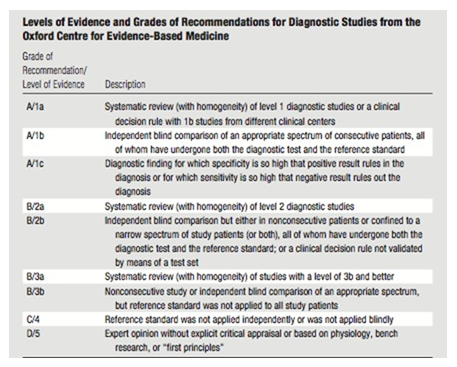
Figure 1: Levels of evidence according to the Oxford Center for Evidence-based Medicine.
3. Results
In total, 1786 (199 articles from Abtpé, 623 from Acta Ortopédica Brasileira, and 964 from Revista Brasileira de Ortopedia) articles were found related to foot and ankle medicine, of which 296 were selected (171 from Abtpé, 54 from Acta Ortopédica Brasileira, and 71 from Revista Brasileira de Ortopedia). Table 1 shows the absolute number of articles published in each journal per year and the percentage regarding the total number of published scientific articles.
|
Journal |
2010 |
2011 |
2012 |
2013 |
2014 |
2015 |
2016 |
2017 |
2018 |
2019 |
Total |
|
Abtpé |
16 |
14 |
17 |
16 |
15 |
19 |
20 |
15 |
18 |
21 |
171 |
|
Acta |
10 |
2 |
9 |
6 |
5 |
1 |
4 |
8 |
3 |
6 |
54 |
|
RBO |
5 |
6 |
9 |
6 |
11 |
3 |
8 |
9 |
6 |
8 |
71 |
Table 1: Total number of publications on foot and ankle medicine by year of publication and journal.
When assessing the distribution by place of origin of the articles, we identified published articles from 11 Brazilian states. The state with the largest number of publications was São Paulo (152, 51.35% of the total). Authors from different countries (i.e., USA, Portugal, China, Chile, Switzerland, England, South Korea, Turkey, Poland, Argentina, and Germany) contributed to the publication of 33 articles in the analyzed national journals. Figure 2 shows the geographic distribution of the articles by place of origin.
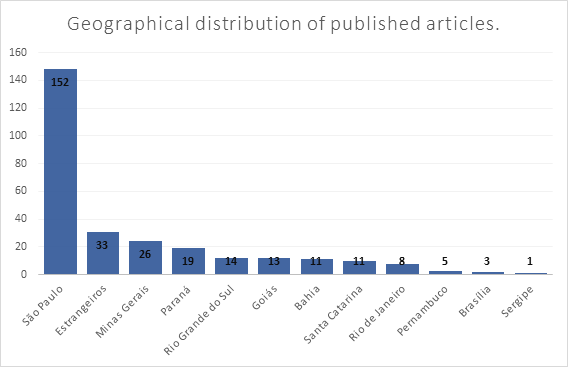
Figure 2: Geographical distribution of published articles.
Legend: The articles from other countries were compiled together and are referred to in Figures as “Foreigners”.
Moreover, results showed that a great number of articles across all three journals were classified as levels 4 and 5 of evidence, with only a few having high levels of evidence. Figure 3 shows the distribution of the absolute number of articles by level of evidence, and Figures 4, 5, and 6 shows the distribution by journal.
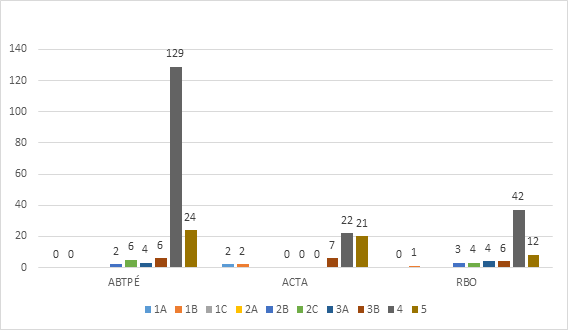
Figure 3: Distribution of articles by level of evidence.
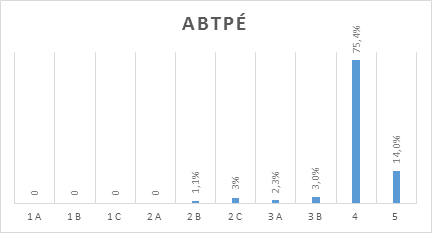
Figure 4: Percentage distribution of articles from Revista Abtpé by level of evidence.
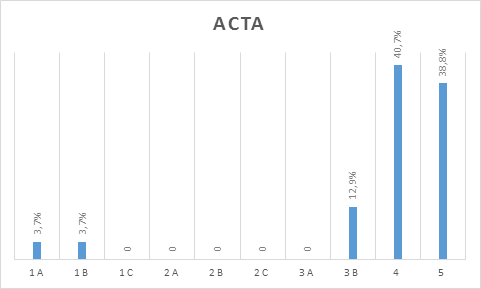
Figure 5: Percentage distribution of articles from Acta Ortopédica Brasileira by level of evidence.
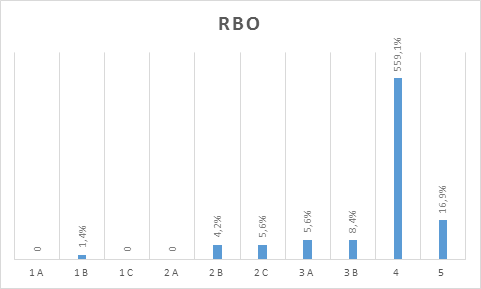
Figure 6: Percentage distribution of articles from Revista Brasileira de Ortopedia by level of evidence.
Regarding discussed topics, the most discussed was present in 64 (21.6% of the total) articles, being related to different types of fractures of the foot and ankle (i.e., 21 on calcaneus fractures, 14 on the talus, 13 on the ankle, 9 on Lisfranc dislocation fracture, 5 on fractures of the base of the fifth metatarsal, 1 on peritalar dislocation, and 1 on stress fractures in children). The second most discussed topic was hallux valgus, with 32 (10.8%) articles, while pathologies of the calcaneus tendon (tendinopathies and ruptures) were studied in 19 (6.4%) articles. Moreover, 13 articles (4.6%) were related to ligament injuries of the ankle and 13 to the treatment of clubfoot. Nonetheless, there were articles on flat feet in adults and children, rigid hallux, metatarsalgia, plantar fasciitis, tarsal coalition, varus and cavus feet in the Charcot Marie Tooth disease, diabetic foot problems, and ankle arthrodesis.
Regarding institution of origin of the research, 31 articles were from the University of São Paulo, 28 from the Federal University of São Paulo, 19 from the Faculty of Medicine of Santa Casa de São Paulo, and 15 from the University of Taubaté. There were other institutions, but they published fewer articles.
4. Discussion
The analysis revealed a significant number of publications in foot and ankle medicine; specifically, Revista Abtpé was responsible for most publications, while Acta Ortopédica Brasileira and Revista Brasileira de Ortopedia accounted for 18.2% and 23.9%, respectively, of the articles dedicated to the topic. When analyzing the period of 2010 to 2019, there was a predominance of publications coming from institutions in the state of São Paulo, accounting for 51.3% of the total; meanwhile, we found published articles from only 11 Brazilian states, denoting that there were no published articles from the other 16 Brazilian states. On the topic, a survey conducted on February 24, 2018, on the website of the Brazilian Society of Orthopedics, showed that there were 521 specialists in foot and ankle medicine in Brazil at that period. Of these, 202 (38.7%) were in the state of São Paulo. By comparing our results with the percentages depicted in the cited survey, we found that 8.5% of the published articles came from Minas Gerais, which accounted for 10.7% of the Brazilian specialists in foot and ankle medicine in 2018; 6.7% of the articles came from Paraná, accounting for 7.1% of the specialists; 4.2% of the articles came from Rio Grande do Sul, accounting for 7.6% of the specialists; 4.2% of the articles came from Goiás, accounting for 2.8% of the specialists; 3.9% of the articles came from Bahia, accounting for 4.8% of the specialists; 3.5% of the studies came from Santa Catarina, accounting for 4.9% of the specialists; 2.8% of the articles came from Rio de Janeiro, accounting for 7.8% of the specialists; 1.0% of the articles came from Pernambuco, accounting for 1.5% of the specialists; 0.7% of the articles came from Brasília, accounting for 2.5% of the specialists; and 0.3% of the articles came from Sergipe, accounting for 0.7% of the specialists. The comparison depicts that even among the states that presented publications, most were underrepresented when considering the percentage of publications in relation to the number of specialists; specifically, only São Paulo and Goiás had a higher percentage of articles compared with the percentage of specialists.
Another relevant fact was the number of international articles, showing a great interest from foreign authors in publishing in these renowned national journals; specifically, 33 articles were identified, corresponding to 11% of the total. Veiga et al., when analyzing articles on knee surgery published by foreigners in national journals within a decade, found that they accounted for only 1.6% of the total of articles reviewed.
Additionally, the classification by level of evidence of articles according to the OCEBM showed a predominance of articles with levels 4 and 5 of evidence across the three evaluated journals. This predominance of articles with a lower level of evidence finds consonance in the literature for international journals; according to Baumhauer, research on the foot and ankle is composed mainly of retrospective case series studies of level 4 of evidence [6]. In 2013, Hunt and Hurwit analyzed level of evidence for scientific literature regarding foot and ankle medicine, finding that 70% of the studies were of level 4, 12% of level 3, 9% of level 2, and 9% of level 1 [7]. Thus, although these studies utilized a classification for the level of evidence other than the one we utilized, they still demonstrate that articles with a lower level of evidence are predominant in this field of research, concurring with our findings. Still, despite the search of editors for authors with research that have levels 1 and 2 of evidence, the history of medicine shows several studies of level 4 of evidence that have changed the way we understand the health/disease process. In the 1980s, Conant and Volverg recognized a single tumor, Kaposi’s sarcoma, in eight homosexual men, with the recognition of this link (i.e., different homosexual mean had the same tumor) later leading to the recognition of the transmission of the HIV virus [8]. Furthermore, the work of Mann and Thompson [9] describing the surgical treatment of the adult flat foot caused by posterior tibial dysfunction was a significant series of cases for the literature, despite its lack of critical evidence; this cited study incited a series of higher-level evidence studies with control groups comparing different treatment options for posterior tibial tendon dysfunction.
Another factor that may have influenced our results is that the present study exclusively evaluated publications in national journals; thus, we cannot rule out the possibility that Brazilian authors publish their articles with a better level of evidence in foreign journals that have a greater impact factor. Given this limitation, it is not possible to generalize our results regarding level of evidence for the whole scientific production in Brazil regarding foot and ankle medicine, with our results being, rather, more confined to the three studied journals. Regarding the most discussed topics, there is a relationship with the diseases or conditions that are commonly found in clinical practice. Trauma, hallux valgus, pathologies of the calcaneus tendon, and ligament injuries are frequent complaints in foot and ankle medicine outpatients within Brazil. Summarizing, our results demonstrate the need for the development of initiatives that stimulate the increase in the number of foot and ankle medicine research, the popularization of scientific production in this field nationwide, and the improvement of the level of evidence of publications on the topic in Brazil.
5. Conclusions
Between 2010 and 2019, 296 articles on foot and ankle medicine were published in the journals Acta Ortopédica Brasileira, Revista Brasileira de Ortopedia, and Revista Abtpé. Most articles originated in the state of São Paulo and were classified, according to the OCEBM, at levels 4 and 5 of evidence. Finally, the most discussed topics were foot and ankle trauma, hallux valgus, pathologies of the calcaneus tendon, and ligament injuries.
Declaration of Interest
No conflict of interest to declare.
References
- Medeiros LR, Stein A. Níveis de evidência e graus de recomendação da medicina baseada em evidências. Rev Assoc Med Rio Grande Do Sul 46 (2002): 43-46.
- Rosário DAV, Gracitelli GC, Luzo MVM, et al. Level of evidence of knee surgery in national journal. Rev Bras Ortop 49 (2014): 13-16.
- Baldwin KD, Bernstein J, Ahn J, et al. Level of evidence gap in orthopedic research. Orthopedics 35 (2012): e1416-e1419.
- Burns PB, Rohrich RJ, Chung KC. The levels of evidence and their role in evidence-based medicine. Plast Reconstr Surg 128 (2011): 305-310.
- Howick J, Chalmers I, Glasziou P, et al. Explanation of the 2011 Oxford Centre for Evidence-Based Medicine (OCEBM) levels of evidence (background document). Oxford Centre for Evidence-Based Medicine.
- Baumhauer J. Evidence vs. anecdote in foot and ankle surgery. J Trauma Orthop 2 (2014): 57-62.
- Hunt KJ, Hurwit D. Use of patient-reported outcome measures in foot and ankle research. J Bone Joint Surg Am 95 (2013): e118 (1-9).
- Rubenstein SA, Jenkin WM, Conant MA, et al. Disseminated Kaposi’s sarcoma in male homosexuals. J Am Podiatry Assoc 73 (1983): 413-417.
- Mann RA, Thompson FM. Rupture of the posterior tibial tendon causing flat foot. Surgical treatment. Bone Joint Surg Am 67 (1985): 556-561.
